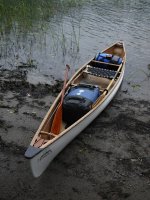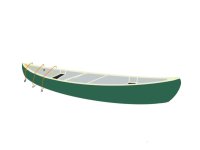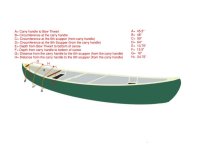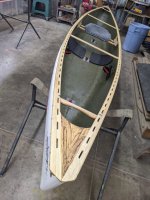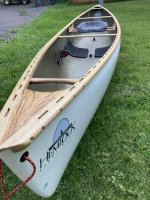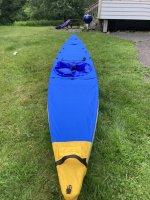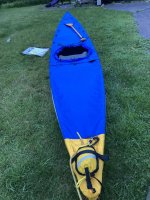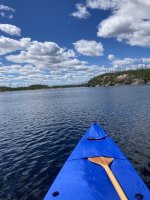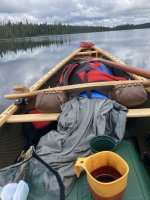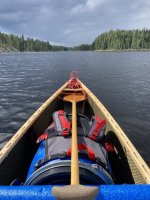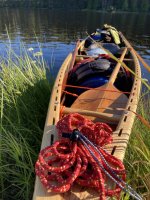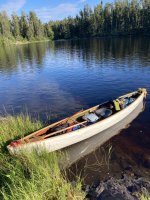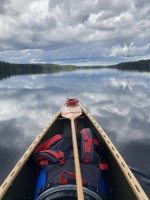Current plan:
Two tugeyes on the bow and stern. Two lowish for lining and two high for grab loops.
CSS spraydeck
End bags
D-rings for end bags and under thwarts for securing gear
Neoprene pads
Foot pegs
Deal bucket seat
I like that outfitting plan, and being able to order some parts and pieces in advance can only help.
About the dual tugeyes I have not seen that solution on a canoe. I wouldn’t want the low lining tugeyes to have much of a loop, if any, lest it drag in the water or inadvertently catch exposed rocks or sunken branches. Maybe just lining tugeyes, wide enough to pass line through, with no attached loop?
The tugeye solution using PVC conduit flange adapters and tubing is an easy DIY. Flange adapters are available at big-box hardware stores in a variety of sizes, up to 1” wide inner diameter. If the tubing goes on the
outside of the flange neck that protrudes inside the hull the full inner diameter is available to pass lining rope through when needed.
Outside (would have looked better had I first painted them black)
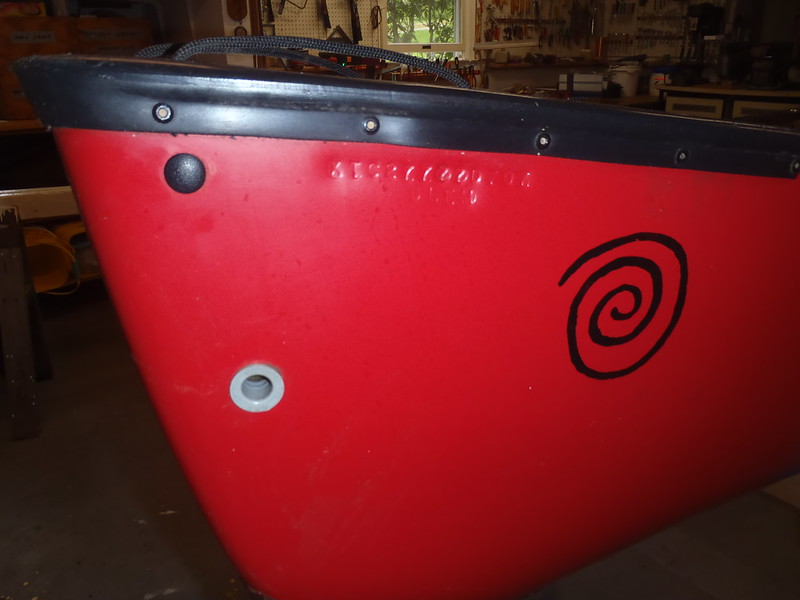 P5260015
P5260015 by
Mike McCrea, on Flickr
Inside
 P5260016
P5260016 by
Mike McCrea, on Flickr
With a CCS spray covers, which will make anything hand grab-able up front (carry handles, deck plate) inaccessibly covered, I want the grab loops long enough that my knuckles clear the tips of the decks. Maybe with some kind of toggle handle for hand comfort.
 P4030013
P4030013 by
Mike McCrea, on Flickr
Ask ALSG how to tie a Bolivian Fisherman’s knot inside the toggle. Ask him why you shouldn’t G/flex in vinyl pad D-rings and then drive home with the canoe a few hours later. I never did do that before, and won’t again.
The other issue with spray covers, for me, is that, with the painter lines secured under Velcro lash straps at the stems there is nothing exposed gunwale-wise to grab en route to reaching the painters. Grabbing at a taut spray cover edge to hold the canoe is futile.
 P1220460
P1220460 by
Mike McCrea, on Flickr
That’s a ways to scurry alongside the hull, with no exposed gunwale to grab hold of keeping the canoe under control.
I could put the bow painter under a Velcro lash strap on the cover within reach, but with covers often rolled open or, my compromise design, partial covers, I’d rather have something more secure and closer at hand.
For non-WW use I put an open clam cleat somewhere within arm’s reach, so I can be at least be holding the bow painter as I exit the canoe, and not swimming after a runaway canoe.
 P1220461
P1220461 by
Mike McCrea, on Flickr
That open cleat is on a utility/sail thwart, but there are mini clam cleats that should fit on a standard thwart. Or roller cam cleats, which might better accommodate thicker diameter paint line.
https://www.amazon.com/Nautos-91025-2-Bearing-Composite-Cleat/dp/B007YM5DWC
I am leery of a cam-held painter in any WW application, where loose lines are a hazard, but I’d need my fingers and toes to count the number of awkward current, wind or wave landings where I have been happy to have a painter in hand the instant I stepped out of a spray decked canoe.
The vinyl pad D-ring locations for float bags will be close-to-bag-end apparent when you fully inflate and cage the bags. Any thoughts as to cage lacing tie points? With a CCS cover the easiest solution for me was to install mini SS D-rings instead of washers behind the snap rivets.
 PB260003
PB260003 by
Mike McCrea, on Flickr
Two birds with one stone, the snap studs need a washer back up inside the hull, and the mini D-rings provide that with no extra holes or attachments needed. FWIW each mini D-ring held 124lbs before the 1/8” pop rivet in a stud broke. With spray cover studs every 8” that is a
lot of combined capacity.
These are pricey, but they are 316 marine stainless and, more importantly, flat on one side so they snap stud pop rivet flush against the inside of the hull, and the aperture opening isn’t cheaters-on thread the needle.
A spray cover doesn’t need mini D’s in lieu of washers backing up every snap stud rivet, but bow and stern as float bag lacing works well.
Vinyl pad D-ring locations for gear might be under the thwarts, or might not; I kinda figure out which bags, packs or barrels are going where in typical tripping guise, and then install the D-rings adjacent for a close, snug webbing strap.
And, I’ve sung the praises before, Northwater Double D anchors (I prefer the black nylon ones) have multiple advantages; both D’s used as a ladder lock for a webbing strap, or the two D’s tensioned in different directions. If I’m putting in a D-ring I’m putting in a double D-ring.
https://northwater.com/products/1-inch-double-d-ring-anchor
As oft mentioned, for ease of installation, the sturdiest, no gluing or screwing, no-holes-drilled tie points are simple webbing loops on the shank ends of thwart and carry handle machine screws. 1” poly webbing with a washer underneath will hold a crazy amount or weight without failing.
You mentioned a barrel earlier. When tripping I am always going to have an initially heavy food barrel, one that that fits sideways, always in the same location, either just aft of the seat or, more often, just past the front thwart, and have come to appreciate a minicel wedge to prevent it from rolling fore or aft.
In my usual tripping canoe that minicel wedge traps the barrel against a thwart, and prevents it from rolling back towards the foot brace bar.
 P2170546
P2170546 by
Mike McCrea, on Flickr
Neoprene pad or minicel pads. Or slices of grey yoga block? Knees, heels, inwale knee bumpers?
Foot pegs, blocks, pedals or a foot brace bar? I have pedals in some boats (well, all of the ruddered boats), but in an open canoe usually prefer a bar; my feet/legs are more comfortable somewhat centered on a bar than spread against the chines, and it is nice to be able to laterally adjust the position of my feet (and legs/knees) from time to time.
Fore/aft foot brace adjustability is a boon; the inch difference between thin water shoes and thick soled mukluks makes a world of
That’s-the-spot comfort.
I’m looking forward to seeing the outfitted SRT. When will you be able to lay hands on it?






